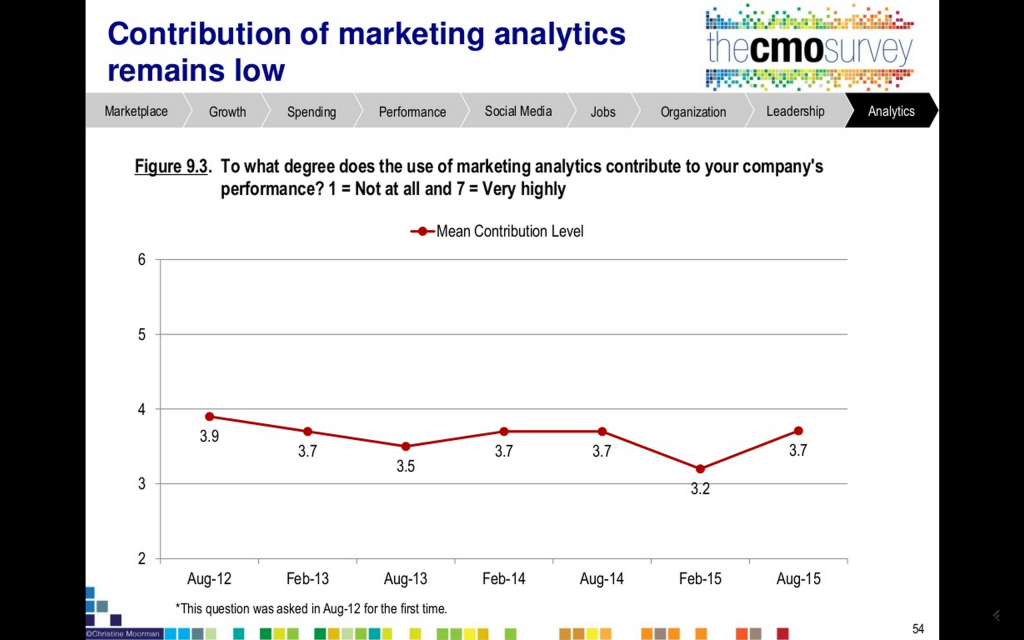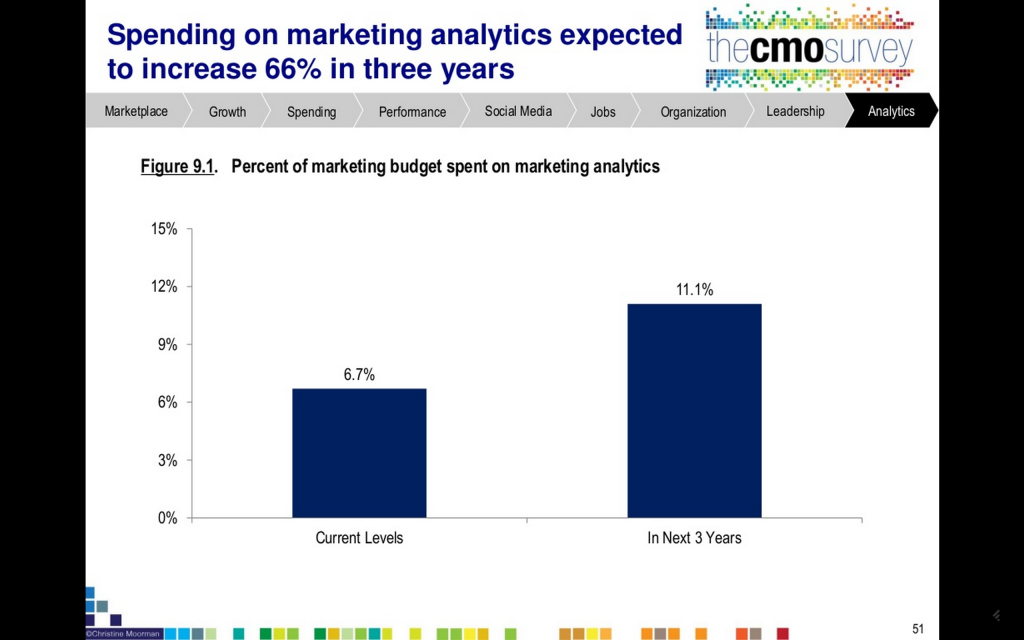How does one assess the landscape for an exploding technology category like marketing analytics? There’s so much confusion and hype around the topic. You’ve heard it all — too much data, we’re drowning in it, woe is us. And, along with that, too many vendors trying to sell us the latest cure. First we were shocked to hear the number of vendors was 1000, now we’re told it’s 2000! The argument that all these vendors create too many data silos is now a refrain we’re hearing more often. Hard to argue with that.
With such high numbers of players comes confusion, and complexity.
But it begs the question: how in the world do you unify all your marketing data to understand it and gain a competitive edge for your organization? Will a platform or single vendor solution emerge? Some of the big players like Oracle, Adobe, and Salesforce are certainly trying, opting in a big way for buy vs. build. (These three have led a frenzy of acquisitions in the marketing technology space.)
Yet significant roadblocks still exist to widespread adoption of marketing analytics in business today — and for companies to extract real value from it. The lack of data science skills we’ve all heard about by now till we’re blue in the face — it’s the “sexiest job title in the country,” blah blah blah. Big shortages, universities scrambling to launch graduate programs, etc, etc. But should this technology really require a PhD in every marketing department and agency in the land? That simply doesn’t compute! Why can’t there be more solutions, more tools, that marketers and general business folks — regular Joes and Janes — can use? Why does it all have to be so complex?
Well, I’m confident more answers will be forthcoming, or at least some enlightenment along the way. It’s still the early innings in this game. An attempt to dissect the landscape was recently undertaken by VentureBeat Insights. It’s a lengthy report, months in the making, which they were kind enough to let me get a look at. It’s entitled “The State of Marketing Analytics: Insights in the Age of the Customer.” Here’s a link to the summary. It provides a good overview of vendors and tools available today across all areas of marketing analytics use cases.
Pity the CMO
The report begins: “There’s more data available than ever, and that’s exactly why it’s so challenging to truly make sense of marketing data. While cloud-based data platforms have accelerated the availability and access of marketing data, it hasn’t made the marketer’s job any easier. It’s just the opposite. ‘Mo’ data, mo’ problems.’”
The VentureBeat report author goes on: “CMOs are more challenged than ever. If they’re going to spend more, they need to deliver more. The latest Duke CMO Survey clearly shows that marketing organizations feel more pressure than ever to prove their value. In fact, 65% of respondents report that pressure from their board or CEO is increasing. At the same time, 65 percent say they lack the ability to really measure marketing impact accurately. That means a huge opportunity is buried in the data, waiting to be uncovered.”
 An opportunity, and also a warning: “Budgets are shifting to the CMO to take advantage of this opportunity — but those who can’t manage the data will simply be taken advantage of”… and that would be by the technology vendors. So, fair warning: they’re always happy to sell you another point solution to add to the pile you may already have. But, cruelly, that can just add to the the complexity — which is the problem.
An opportunity, and also a warning: “Budgets are shifting to the CMO to take advantage of this opportunity — but those who can’t manage the data will simply be taken advantage of”… and that would be by the technology vendors. So, fair warning: they’re always happy to sell you another point solution to add to the pile you may already have. But, cruelly, that can just add to the the complexity — which is the problem.
Just Give Me the Data That Matters
Two of the insights from the VentureBeat report that I found interesting:
1) Today, there’s a “general lack of ability to prove which data matters” — which it attributes to a skills gap. And that lack of ability can be at least partially ascribed to a lack of “self serve” tools — those that are “marketer ready.” I take that to mean tools that a non-technical marketing person can use. Or at least that a data scientist, whom you must train in marketing, could easily use. (But first you must recruit and hire that person in an extremely competitive talent marketplace. More on that later.)
2) Measuring marketing ROI is not getting easier, as you might think. It’s actually getting more complex and challenging. Why? Because “the answers to these performance metrics are buried in marketing data from dozens, if not hundreds of data sources. And the first step is understanding what those data sources are all about.”
Sounds like a ton of work, huh? It is.
More on that last point, this from a post called “Marketing technology is eating the customer journey”):
“Today’s marketers own more customer data and touchpoints than ever before, and more than any other department. New digital channels and devices — including search, social media, and mobile — have empowered consumers and complicated the customer journey. On each of these, consumers create unprecedented amounts of data about themselves and their interests. And as a result, both the process and technology of modern marketing have expanded as a result of these changes in consumer behavior… Today, digital offers new channels for engagement and accurate measurements to learn from. What’s more, as marketing’s reach has grown, the traditional roles of sales and support have diminished because consumers increasingly inform and support themselves.”
And more — this from “Building a marketing tech stack that drives retention,” a post by martech vendor Sailthru:
“With more than 2,000 companies across the marketing technology landscape, it’s daunting to figure out exactly which products and services you really need… Unlike more mature technology sectors, marketing tech does not yet have a consistent, established ‘stack’ of components.”
The importance of measuring marketing performance in today’s enterprise is further emphasized by a finding in the VentureBeat “State of Marketing Analytics” report:
“Despite marketer confidence in their ability to use the data effectively being relatively low, marketers across all levels, including CMOs, view marketing analytics as being extremely important to the financial success of the firm, not just the marketing organization.”
There’s a lot riding on the shoulders of the CMO. And marketing performance or ROI — the by-product of marketing analytics technology — is a huge part of that weight.
In its survey, VentureBeat asked the marketing execs it surveyed (sample size: 1000+) what were their use cases for marketing analytics. Here are the top five:
- Customer acquisition
- Customer retention
- Ad/campaign effectiveness
- Customer lifetime value
- Customer behavior/audience insights
Duke Isn’t Only Good at Basketball
Another key source for understanding the field of marketing technology today, as mentioned earlier, is the Duke CMO Survey. This semiannual survey surfaces trends in the budgets and priorities of chief marketing officers at top U.S. firms. The February  2015 study was conducted across a sample of 2,630 marketing execs. Here are two key questions they asked those execs about marketing analytics; there are some surprising answers to the second one:
2015 study was conducted across a sample of 2,630 marketing execs. Here are two key questions they asked those execs about marketing analytics; there are some surprising answers to the second one:
1) What are the areas in which you are using marketing analytics to drive decision-making?
- Customer acquisition 37.8%
- Customer retention 30.2%
- Social media 27.4%
- Product line/assortment optimization 26.4%
- Branding 26.0%
- Pricing strategy 23.3%
- Promotion strategy 21.9%
- Marketing mix 19.8%
- Multichannel marketing 14.6%
2) What factors prevent your company from using more marketing analytics?
- Marketing analytics does not offer sufficient insight 21.9%
- Marketing analytics does not arrive when needed 19.8%
- Marketing analytics is overly complex 19.4%
- Marketing analytics are not highly relevant to our decisions 19.1%
Those negative answers should certainly be a wake-up call for the industry.
Two key bright spots in the Duke report (especially for vendors), courtesy of the TrackMaven blog:
1) Marketing budgets are expected to rebound to the highest point in more than three years. Top marketing execs have lofty budgetary expectations. Over the next 12 months, CMOs expect marketing budgets to increase by 8.7%, the highest forecasted increase since August 2011.
2) CMOs expect their spending on marketing analytics to nearly double. Over the next three years, CMOs expect their spending on marketing analytics — defined by the Duke survey as “the creation and use of quantitative data about customer behavior” — to increase by 83%, up from a 6.4% share of the overall marketing budget to 11.7%.
So there are some positives. But another big downer from the Duke CMO survey:
“Only 40% of CMOs report the ability to prove the impact of short-term marketing spend on their business, and even fewer (34%) can qualitatively prove that impact in the long term.”
The obvious conclusion, again: there is much work ahead.
Wait, What, There’s a Skills Gap? (Duh)
VentureBeat’s “State of Marketing Analytics” report says marketing organizations need to “cultivate hard data science skills to stay ahead of the curve.” It notes that Gartner predicted 4.4 million data science jobs will be available by this end of this year, but only one-third of them will be filled.
Here’s another view on the topic of the skills shortage (from “Marketers are about to make new friends — or not — with data scientists”):
“Data scientists will soon take a lot of jobs away from marketers. The reasons are simple:
1) There’s already more data produced and mined every day than anyone can make sense of. Business gets this and is moving to incorporate data analytics into every facet of the organization.
2) Virtually every marketing technology of note (and there are many) is either a data analytics solution or a solution almost wholly reliant on reams of data.
3) Marketers simply don’t have the required skills to leverage these techs, or the underlying data. Unfortunately, that seems to be true at every level of the marketing organization.
Net-net, the ecosystem is changing, and the winds do not favor marketers with no data science game.”
The writer cites three types of firms in which he believes traditional marketers will soon be displaced by a new breed of data scientists cum marketers: enterprises, agencies, and marketing technology vendors. Yep, that pretty much covers it all!
The implication isn’t that overall marketing employment will not be increasing (though it might) — but that its makeup will be reapportioned. Marketing will become more about science than art. (Not news to those of us marketers who’ve been following this shift for a while.) Lesson: sharpen up those analytics skills.
But all this talk about the need for more advanced-degree data geeks would be lessened if vendors could just develop tools that non-techies can use. It’s hard to argue that, in the software technology world, those that can make the complex simple always seem to win.
One category of marketing analytics software where this is already being seen was called out in the VentureBeat report: “Self-service analytics with a big focus on data visualization (like Tableau) has found its way into marketing organizations at many levels.” Other vendors are surely noticing that one (very successful) company is proving the point.
What’s a Marketer To Do, Now?
With all this change going on in marketing, and science gaining on art in job descriptions and resumes everywhere, you can’t sit still. But there is no simple, universal action plan. The VentureBeat reports says it well: “Marketing analytics is as complex as it is unique to the individual performing it. There is no one way of prioritizing the right kinds of metrics, for the right channels, for the right products, with the right people, under the right organizational model.” Here’s a summary of their recommendations:
- Develop a completely custom digital marketing analytics roadmap that incorporates establishing a well-defined strategy for your analytics organization firmly aligned to business outcomes.
- Then, establish your technology requirements.
- Next, define all the messy organizational requirements for your analytics strategy.
And they rightfully end with this point: “Your metrics and KPIs will be completely unique to you, but consult with experienced marketing analytics agencies in your industry. They’ll help you figure out which metrics to track.“
Land of 10,000 Data Pros (well, almost)
It goes without saying that one big thing you need to do is keep learning. Soak in as much as you can. In that vein, I must  mention an upcoming conference here in what myself and my data colleagues also like to call “The State” of analytics — Minnesota! (I’m co-organizing it with Lizzy Wilkins, a marketing-focused data scientist.)
mention an upcoming conference here in what myself and my data colleagues also like to call “The State” of analytics — Minnesota! (I’m co-organizing it with Lizzy Wilkins, a marketing-focused data scientist.)
It’s the 2nd Marketing Analytics conference from MinneAnalytics, so “MAMA2” for short, and it’s scheduled for January 22, 2016 in Minneapolis. It will be educational in nature, and we expect more than 600 attendees. MinneAnalytics is the largest local/regional organization in the country for data professionals, with more than 5600 members from the region (and growing), from startups to our many Fortune 500s, across a wide range of industries. It hosts free, sponsor-supported conferences. More details on MAMA2 will be forthcoming on the MinneAnalytics web site. (You may also follow the Twitter feed.)
One thing I can say about the conference: it will be keynoted by the leading voice in the country today on the topic of marketing technology. We have spots for up to 20 other experts to give presentations on a variety of marketing analytics technologies and case histories. Those speakers (and sponsors) are now converging. It’s sure to be an enlightening event.
(Note: This post was also published at Minnov8.)


Fantastic post Graeme! Kirsten Chapman addressed the same issues in a post on Webbiquity a couple of months ago, making the case that to cut through the tactical metrics clutter and get true C-level measures, CFOs need to monitor KPIs relating to the the brand (awareness and preference), competitive webshare (like marketshare for online presence) and website performance/effectiveness. You and your readers may find this post of interest as well: https://www.measuremybrand.com/blog/what-cmos-need-to-know-that-will-keep-ceos-and-cfos-happy/
Thanks, Tom. Hope to see you and Kirsten at the MAMA2 conference in January.